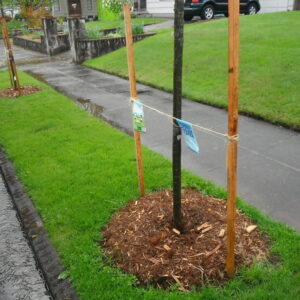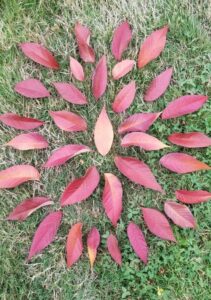Tag: fall tree care
Leaflet – Watching the Seasons Change

You’re not the only one who’s noticing that the days are getting shorter. Our trees are noticing, too, and they’re taking it as a sign that the growing season is over. How do they notice? A hormone response is triggered by the shorter daylight hours, the angle of the sun, the cooler temps. This past month, you may have noticed a spring-like flush of herbaceous growth on your trees—one final push before autumn. That new growth will harden into woody material tough enough to survive our first frost in November.
Leaves on some deciduous trees will start changing color, a welcome sign of the cooler seasons after an especially hot summer. In a process called abscission, trees reabsorb the nutrients stored in the leaves before detaching and shedding them. Chlorophyll, which gives leaves their green color, is one of the first things to be absorbed, which is why we see them change color. But fallen leaves still have plenty of nutrients, which is why we encourage you to leave the leaves. Trees are putting those leaves there on purpose, to enrich the soil for their roots.
Most deciduous trees shed leaves in the fall. Some don’t though! Scarlet oaks, swamp white oaks, and many evergreens shed leaves in the spring as new growth emerges
For now, the best thing we can do is watch the weather, just like our trees are. Continue your watering regime until we’ve had one inch of rain in a week. After that, we’ll be out of the dry season and beyond the growing season when trees actively expand their canopies as they photosynthesize. And it happens to coincide with the timing for our trees to transition into winter dormancy, when their sap returns to their roots.

Roots can grow year round in the right conditions—moisture, air, and temperature—which is why we plant when we do, so trees can focus on establishing their roots. To help keep those conditions right for your young tree, make sure you replenish your mulch in the next couple months. One inch of mulch is a windbreaker, three inches is like a down jacket – and we want that year round, protecting against temperature extremes. Tree roots can grow 365 days a year as long as they have some moisture and a moderate soil temperature, both things that mulch provide.
This time of transition can be really exciting. It’s always remarkable to feel like summer is barely over, but by Halloween, which is now right around the corner, most of our trees will be dormant. As the seasons change, so do the needs of our young trees. So watch the weather, and stay tuned to Treemail for best practices for each season!
Fall Tree Care

Leave the leaves!
Fall brings cooler days and evenings, an extra layer when we head out, and the striking colors on display gifted to us by nature. For many of us fall also means raking leaves–but it shouldn’t. In fact, fall tree care should include leaving the leaves!
We have this habit as a society to rake and dispose of leaves, but leaves are vitamins for plants and magic for building the health and vitality of soil. Throughout the growing season trees are producing energy in the form of sugar, or, sap. This time of year, as we start to see the leaves changing color, that’s the indication that the sap is crawling from the leaves, into twigs and branches, down the trunk and into the roots for winter.
When leaves fall, much of the tree’s energy, in the form of sap, goes into the root system encouraging new root growth (FOT gets busy this time of year very deliberately: planting trees now gives the roots a head start and a chance to anchor themselves). The rest of the leaf energy falls from the tree and settles on the ground–these leaves are literally vitamins for the root system that is primarily about 12-18” below the soil surface.
When we remove leaves we are actually interrupting a process called nutrient cycling, which is when the leaves break down and feed the roots. Rain carries the nutrients downward and provides them to trees and other plants water-solubly. So, leave the leaves! At the base of trees, in your garden beds, anywhere you want healthy soil in the spring.

Mulching: it’s not just for spring
Think about it: the forest floor is perfectly mulched. The act of transplanting a tree is unnatural, what we do planting trees doesn’t happen in nature, they don’t jump around and move. So, as tree stewards, we are trying to make trees feel comfortable, to restore a natural setting–as much as possible, of course, in an urban area. Street trees have it tough in this regard: They are often in compacted soil that is depleted, and it’s depleted because, unlike in the forest, we often remove leaves and clippings, and soil gets very compacted in the built environment.
So in addition to leaving the leaves, refresh mulch as needed. Create a “sacred mulched zone” ideally 2-3 feet in each direction from the base of the tree; this should be and remain a grass-free zone, and it should be an area that won’t be disturbed. If the tree is in a small space, such as a street tree next to the sidewalk, maintain it in the form of a square if there’s grass to mow since it’s easier to mow along a straight line than around a ring of mulch.
Why mulch? 50% of healthy soil is air & water pockets. How do we get these pockets? Partly through roots, just the process of roots growing down. And when some of the roots die and decompose they leave space in their wake, where fungi and bacteria grow and bring life to soil. Those fungi and bacteria grow where the soil isn’t, which is why compacted soil can be a challenge to bring to life.
When trees are transplanted – the most stressful day of a tree’s life – we want to foster new growth to set the new tree on the path of health and vitality. Tree roots can grow year round as long as the temperature of the soil is moderate (think of mulch as a down jacket for the soil) and there is the presence of moisture, both of which are provided by mulch! One inch of mulch is a windbreaker, three inches is like a down jacket – and we want that year round, protecting against temperate extremes. Not only is mulch insulating, it’s also thirst-quenching since wood chips hold water.
Fall tree care should start with building the soil with organic matter through application of mulch, setting the tree up for success, which is ever more important in a changing climate. Do take some time to get your mulching and non-raking done, and then tune in next month when we share the next stage of your fall tree care (hint: it rhymes with strewn, but don’t start yet!).
Check out our website for more tree care information and resources.
Our friends at Chip Drop are a great source for mulch, learn more here!
